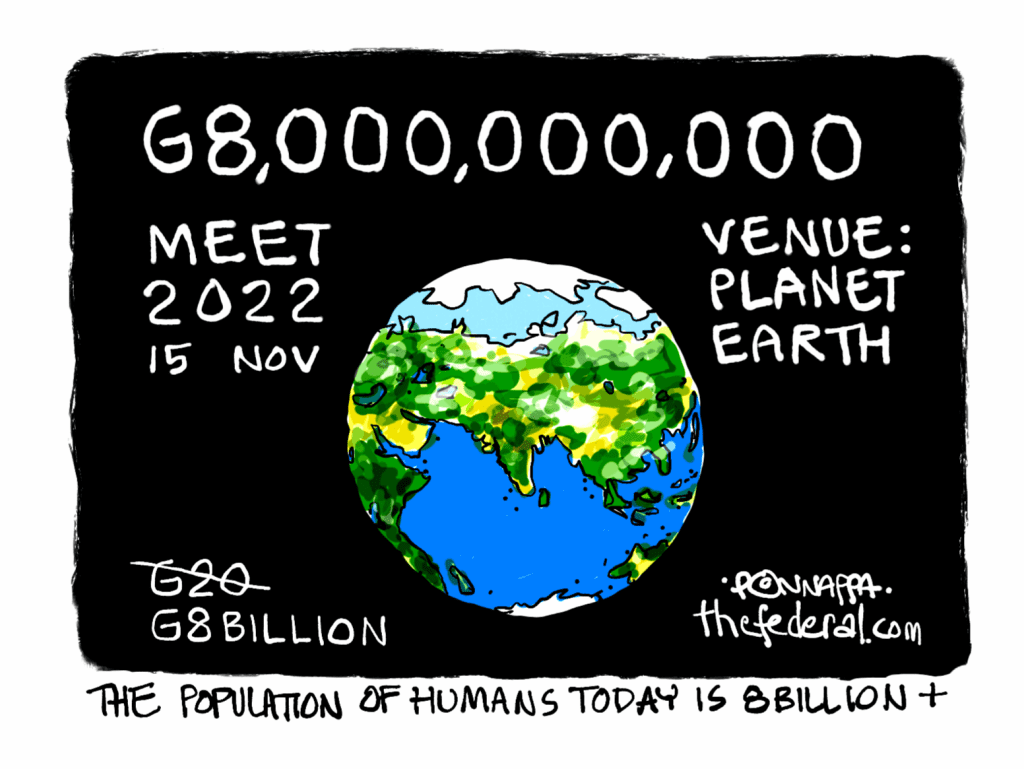
India top contributor with added 177 m as world population touches 8 b

World population touched 8 billion on Tuesday, with India being the largest contributor to the milestone, having added 177 million people, the UN has said.
India is expected to surpass China as the world’s most populous nation by next year. In fact, China’s contribution to the next billion in the global population is projected to be in the negative, the UN said.

A girl born in Tondo, Manila, is being considered as the symbolic 8 billion person in the world—symbolic because it is hard to calculate the exact number of people in the world. The Philippines’ Commission on Population and Development celebrated Vinice Mabansag’s birth at Dr Jose Fabella Memorial Hospital at 1.29 am (local time) and posted her photos on Facebook.
1 billion added in 11 years
It has taken 11 years for one billion people to be added to the global population, with growth gradually slowing down. According to the UN, it could take 15 years to reach nine billion. The UN does not expect to reach 10 billion until 2080.
Watch: Indian cities stare at growing population crisis as world population nears 8 billion
The UN Population Fund (UNFPA), in a special graphic to mark the global population reaching 8 billion, said Asia and Africa have driven much of this growth. These two continents are expected to drive the next billion by 2037, while Europe’s contribution will be negative due to declining population.
China was the second largest contributor (73 million) to the latest addition of a billion. The UNFPA believed world population will reach a peak of around 10.4 billion people during the 2080s and will remain at that level until 2100.
More than half of the projected increase in the global population up to 2050 will be concentrated in eight countries: the Democratic Republic of the Congo, Egypt, Ethiopia, India, Nigeria, Pakistan, the Philippines, and the United Republic of Tanzania.

Highest growth in low-income and lower-middle-income countries
For the increase from 7 to 8 billion, around 70 per cent of the added population was in low-income and lower-middle-income countries. For the increase from 8 to 9 billion, these two groups are expected to account for more than 90 per cent of global growth, the UN said.
According to it, the global increase in the population under the age of 65 will occur entirely in low-income and lower-middle-income countries between now and 2050. Population growth in high-income and upper-middle income countries will occur only among those aged 65 or more.
Also read: World Population Day 2022: History, theme, ‘8 billion opportunities’
The World Population Prospects 2022, released in July this year, said India’s population stood at 1.412 billion in 2022, compared to China’s 1.426 billion. India is projected to have a population of 1.668 billion in 2050, ahead of China’s 1.317 billion by the middle of the century.
According to UNFPA estimates, 68 per cent of India’s population is between 15 and 64 years old in 2022, while people aged 65 and older were seven per cent of the population. The report said global population was growing at its slowest rate since 1950, having fallen under 1 per cent in 2020.
Significantly, it took the world population roughly 11 years to grow from 6 to 7 billion, the same as that from 7 to 8 billion. The symbolic 5 billionth baby was born in 1987.
“Brace for ageing population”
At the launch of the report in July, Under-Secretary-General for Economic and Social Affairs, Liu Zhenmin, had said that countries where population growth has slowed must prepare for an increasing proportion of older persons and, possibly, a decreasing population size.
Also read: South’s share in Indian population lowest in 2022: Census estimates
“China provides a clear example. With the rapid ageing of its population due to the combined effects of very low fertility and increasing life expectancy, growth of China’s total population is slowing down, a trend that is likely to continue in the coming decades,” Liu said.
The WHO pointed out that China has one of the fastest-growing ageing populations in the world. “The population of people over 60 years in China is projected to reach 28 per cent by 2040, due to longer life expectancy and declining fertility rates,” the WHO said.
By 2019, there were 254 million people aged 60 and above in China, and 176 million aged 65 and above.
(With agency inputs)

